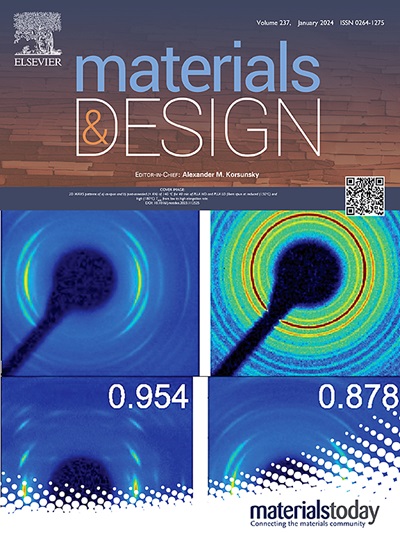Shape morphing of additively manufactured metallic kinematic structures to trace single- and doubly-curved surfaces
IF 7.9
2区 材料科学
Q1 MATERIALS SCIENCE, MULTIDISCIPLINARY
引用次数: 0
Abstract
Biocompatible and shape-morphing metallic structures have been proposed for musculoskeletal applications to provide structural support to bony tissues. However, fabricating these structures to conform to a wide range of curvatures, including both single and double curvatures, remains a significant challenge. In this study, we present and analyze structures featuring a regular tiling network connected by spherical joints, forming a chain mail-like mechanism capable of adapting to complex geometries with clay-like flexibility. Simulations using a multibody kinematics model show that parameters such as unit cell shape, dimension ratios, and substrate curvature affect the shape-matching abilities of the structure. Experimental validation using specimens additively manufactured through laser-based powder bed fusion (from Ti6Al4V) and full-field strain measurements performed through digital image correlation confirms the simulation results, demonstrating that reducing structural density (i.e., fewer bodies, struts, and joints per unit area) improves shape adaptability. However, the improved shape morphing capability often comes at the expense of mechanical strength under uni-axial tensile loads. These findings provide a framework for optimizing structures designed to achieve efficient surface conformance and adaptability in load-bearing applications.

增材制造金属运动结构的单曲面和双曲面形状变形
生物相容性和变形金属结构已被提出用于肌肉骨骼应用,为骨组织提供结构支持。然而,制造这些结构以适应广泛的曲率,包括单曲率和双曲率,仍然是一个重大挑战。在这项研究中,我们提出并分析了由球形关节连接的规则瓦片网络结构,形成了一种具有粘土般柔韧性的链状锁子结构,能够适应复杂的几何形状。利用多体运动学模型进行的仿真表明,单元格形状、尺寸比和衬底曲率等参数会影响结构的形状匹配能力。通过激光粉末床熔接(Ti6Al4V)增材制造的试样和通过数字图像相关进行的全场应变测量进行的实验验证证实了模拟结果,表明降低结构密度(即单位面积内较少的主体、支撑和接头)可以提高形状适应性。然而,在单轴拉伸载荷下,形状变形能力的提高往往是以牺牲机械强度为代价的。这些发现为优化结构提供了一个框架,旨在实现有效的表面一致性和承重应用的适应性。
本文章由计算机程序翻译,如有差异,请以英文原文为准。
求助全文
约1分钟内获得全文
求助全文
来源期刊

Materials & Design
Engineering-Mechanical Engineering
CiteScore
14.30
自引率
7.10%
发文量
1028
审稿时长
85 days
期刊介绍:
Materials and Design is a multi-disciplinary journal that publishes original research reports, review articles, and express communications. The journal focuses on studying the structure and properties of inorganic and organic materials, advancements in synthesis, processing, characterization, and testing, the design of materials and engineering systems, and their applications in technology. It aims to bring together various aspects of materials science, engineering, physics, and chemistry.
The journal explores themes ranging from materials to design and aims to reveal the connections between natural and artificial materials, as well as experiment and modeling. Manuscripts submitted to Materials and Design should contain elements of discovery and surprise, as they often contribute new insights into the architecture and function of matter.
 求助内容:
求助内容: 应助结果提醒方式:
应助结果提醒方式:


